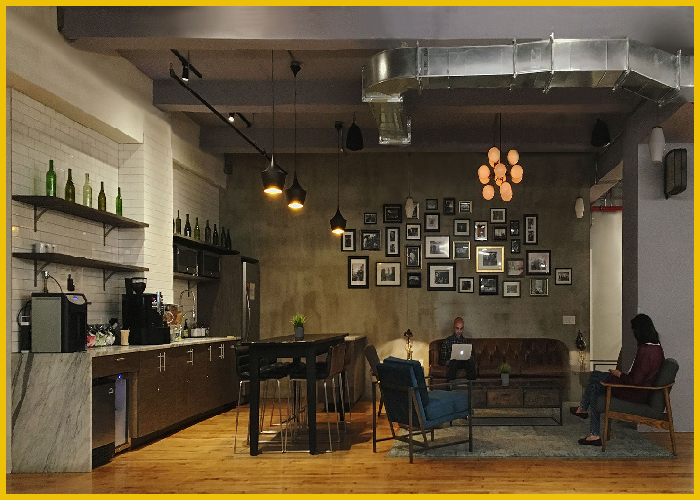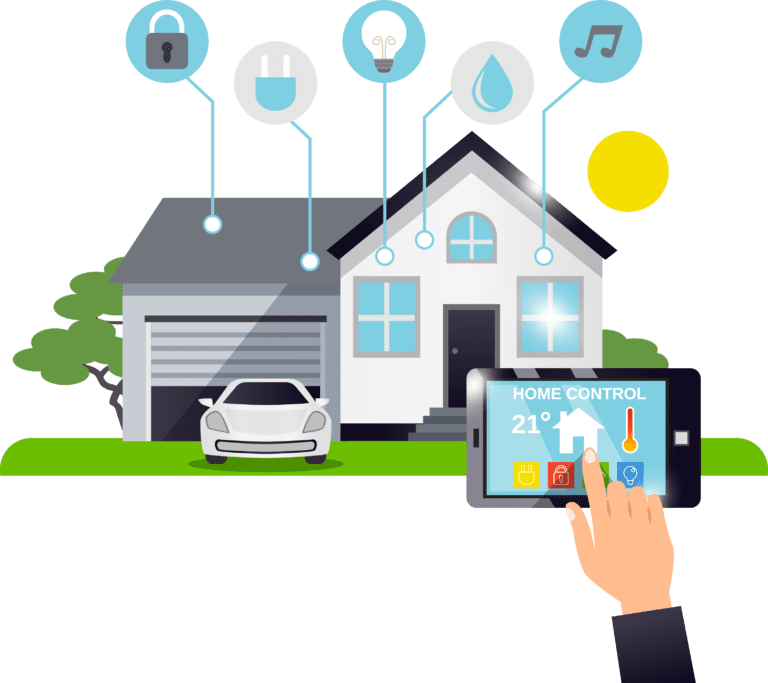What is a Smart Home? All You Need to Know

The concept of the smart home stands out as a beacon of innovation and convenience. Imagine a living space where your lights adjust to your mood, your appliances communicate with each other, and your security system is always alert and accessible at your fingertips. This is the promise of the smart home—a dwelling equipped with a network of interconnected devices and systems that automate tasks and provide seamless control over various functions.

What is a Smart Home?
A smart home is equipped with Internet-connected devices that enable remote management and monitoring of systems and appliances such as lighting, heating, ventilation, air conditioning (HVAC), entertainment systems, security cameras, and more. These devices can communicate with each other through a home network, allowing for automated routines and responses based on user preferences and environmental conditions.
Features of Smart Homes
Automation: Devices and systems in a smart home can be programmed to perform tasks automatically. For example, smart thermostats can adjust the temperature based on occupancy and time of day, while smart lighting systems can turn on or off based on motion sensors or preset schedules.
Remote Control: With the help of mobile apps or voice assistants like Amazon Alexa or Google Assistant, homeowners can control and monitor their smart devices from anywhere with an internet connection. This allows for greater flexibility and convenience in managing home functions even when away from home.
Energy Efficiency: Smart homes often feature energy-efficient appliances and systems that can be optimized for better energy management. For instance, smart meters can provide real-time data on energy usage, helping homeowners make informed decisions to reduce consumption and lower utility bills.
Security: Integrated security systems in smart homes include features such as smart locks, video doorbells, and surveillance cameras that provide real-time alerts and monitoring. Some systems can even integrate with smart lighting and alarm systems to enhance home security further.
Entertainment and Comfort: Smart entertainment systems allow users to stream multimedia content seamlessly across different devices and rooms. Additionally, smart home hubs can integrate entertainment controls with other functions like lighting and temperature for a personalized and comfortable environment.

Benefits of Smart Homes
Smart homes offer a range of benefits that significantly enhance convenience, efficiency, and security. By integrating advanced technologies such as internet-connected devices, automation systems, and artificial intelligence, smart homes provide seamless control over various aspects of daily living.
Homeowners can remotely manage lighting, climate control, and security systems through smartphones or voice commands, allowing for tailored environments that improve comfort and energy efficiency. Smart thermostats, for example, learn user preferences and optimize heating and cooling to reduce energy consumption and costs. Enhanced security features, such as smart locks, cameras, and motion sensors, offer real-time monitoring and alerts, enhancing home safety and allowing for remote access control.
Additionally, smart home systems can integrate with other technologies to streamline daily routines, such as automating tasks like watering plants or managing grocery lists. The ability to gather and analyze data also provides insights into usage patterns, helping homeowners make informed decisions about their energy consumption and home management. Overall, the convenience, efficiency, and enhanced security provided by smart home technologies contribute to a more comfortable and manageable living environment.
Challenges and Considerations
Smart homes, while offering numerous benefits, also face a range of challenges and considerations.
Privacy and Security are primary concerns, as the integration of numerous internet-connected devices increases the risk of cyberattacks and unauthorized access. Ensuring robust security measures, such as encryption and regular software updates, is crucial to protect sensitive data and personal information.
Interoperability is another challenge, as compatibility issues between different devices and platforms can complicate system integration and reduce functionality. Additionally, cost can be a barrier, as the initial investment in smart home technology, including devices and installation, can be substantial.
Complexity and Usability are also considerations, as some users may find the technology difficult to set up and operate, potentially leading to frustration or underutilization.
Data Management is a concern as well, with the collection and storage of large amounts of personal data raising questions about data privacy and management.
Lastly, dependence on Technology poses risks; failures or malfunctions in smart home systems could disrupt daily life and routines, highlighting the need for reliable and backup systems. Addressing these challenges effectively is essential to ensuring that smart home technologies deliver their intended benefits while safeguarding user privacy and enhancing overall usability.
Future Trends
The future of smart homes is promising, with advancements in artificial intelligence (AI) and machine learning enhancing automation capabilities and user interactions. Integration with smart cities and the Internet of Things (IoT) will further transform how homes interact with their surroundings, optimizing resource use and enhancing quality of life.

1. Convenience and Automation
One of the primary reasons to adopt smart home technology is the convenience it offers through automation. Imagine arriving home to lights that automatically turn on, thermostats that adjust to your preferred temperature, and doors that unlock as you approach—all without needing to manually operate each device. Smart homes enable automation of routine tasks, saving time and effort in daily life.
2. Enhanced Security and Safety
Smart home systems provide advanced security features that enhance the safety of your home and peace of mind. Integrated security cameras, motion sensors, and smart locks allow for real-time monitoring and remote access, enabling you to check in on your home from anywhere. Alerts and notifications keep you informed of any unusual activity, deterring potential intruders and ensuring the safety of your family and belongings.
3. Energy Efficiency and Savings
Smart home devices are designed with energy efficiency in mind, helping homeowners reduce their environmental footprint and save on utility bills. Features such as smart thermostats, which learn your behavior and adjust heating and cooling schedules accordingly, and energy-efficient appliances that can be controlled remotely contribute to significant energy savings over time.
4. Comfort and Personalization
Smart homes offer unparalleled comfort and personalization through customizable settings for lighting, temperature, and entertainment systems. With voice commands or mobile apps, you can create personalized environments tailored to your preferences, whether you’re relaxing, entertaining guests, or working from home. Smart home technology adapts to your lifestyle, making your living spaces more enjoyable and efficient.
5. Remote Monitoring and Control
The ability to monitor and control your home remotely is a game-changer, especially for frequent travelers or busy homeowners. Whether you’re at work, on vacation, or simply away from home, remote access via smartphone apps allows you to check security cameras, adjust settings, and receive alerts in real time. This connectivity provides peace of mind and ensures that you’re always connected to your home.
6. Integration and Interconnectivity
Smart home technology fosters integration and interconnectivity between devices and systems within your home. By connecting smart devices through a central hub or platform, such as Amazon Alexa or Google Home, you can create seamless interactions and automate routines across different functionalities. This interoperability enhances the overall efficiency and functionality of your smart home ecosystem.
Considerations and Challenges
While the benefits of smart home technology are compelling, there are considerations to keep in mind:
Cost: Initial investment in smart devices and installation may be higher compared to traditional home systems, although prices are becoming more competitive as technology evolves.
Compatibility: Ensuring compatibility between different smart devices and platforms from various manufacturers is essential to avoid compatibility issues and ensure seamless operation.
Privacy and Security: With increased connectivity comes the need for robust cybersecurity measures to protect personal data and ensure the secure operation of smart devices.

The cost to install a smart home system can vary significantly based on several factors, including the size of your home, the complexity of the system, the number of devices and features you want to include, and whether you choose professional installation or opt for a DIY approach. Here’s a breakdown of the costs involved:
1. Smart Home Components
Hub or Controller: Many smart home systems require a central hub or controller to connect and manage all devices. Prices for hubs typically range from $50 to $300 or more, depending on the brand and features.
Devices: Costs for individual smart devices vary widely.
When investing in smart home technology, it’s helpful to understand the price range for various devices.
Smart thermostats typically cost between $150 and $300, offering advanced temperature control and energy efficiency.
Smart lighting can range from $20 to $50 per bulb, or you might opt for a starter kit priced between $100 and $300 to outfit your home.
Smart locks generally fall within the $100 to $300 range per lock, providing enhanced security and convenience. Security cameras are available from $100 to $400 each, allowing for flexible monitoring solutions.
Smart speakers, such as Amazon Echo or Google Nest, are priced between $50 and $300, offering voice-controlled assistance and home automation integration.
Smart appliances, on the other hand, have a wide price range depending on the type and brand, reflecting their diverse functionalities and features.
2. Installation Costs
Professional Installation: Hiring a professional to install your smart home system can ensure it’s set up correctly and integrated smoothly. Costs for professional installation vary, but you can expect to pay anywhere from $50 to $150 per hour for labor. The total installation cost will depend on the complexity of the system and the number of devices being installed.
DIY Installation: If you choose to install the system yourself, you can save on labor costs but should consider the time and effort required to set up each device and ensure they work together seamlessly.
3. Additional Costs
Network Infrastructure: Depending on your existing Wi-Fi network and its coverage, you may need to upgrade your router or add Wi-Fi extenders to ensure reliable connectivity for all smart devices.
Subscription Fees: Some smart home systems or services may require monthly or annual subscription fees for additional features or cloud storage for security cameras and recordings.
Total Cost Estimates
Basic Smart Home Setup: For a simple setup with a few smart devices and DIY installation, costs can range from $500 to $1,500.
Moderate Smart Home Setup: A more comprehensive system with additional devices and professional installation could cost between $1,500 to $5,000.
Advanced Smart Home Setup: High-end systems with extensive automation features, multiple devices, and professional installation may exceed $5,000 or more.
It’s essential to plan your smart home installation based on your budget and specific needs. Researching different brands, comparing prices, and consulting with professionals can help you create a smart home that enhances convenience, security, and energy efficiency within your desired budget.
In conclusion, while the initial investment to install a smart home system can vary depending on factors like the size of your home, the complexity of the setup, and the types of devices chosen, the benefits of embracing smart home technology are substantial. From enhancing convenience and security to improving energy efficiency and offering remote monitoring capabilities, smart homes provide a modern and personalized living experience.
Whether you opt for a basic setup with essential devices or a more sophisticated system with advanced automation features, investing in smart home technology can streamline daily routines, increase comfort, and ultimately contribute to a more connected and efficient household. As technology continues to evolve, smart homes represent not just a trend but a fundamental shift towards more intelligent and sustainable living spaces. By carefully planning your smart home installation and choosing devices that align with your lifestyle and priorities, you can enjoy the convenience and peace of mind that comes with a smarter, more integrated home environment.



Post Comment